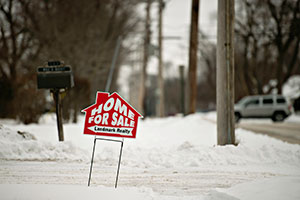Home Sales Drop as Lack of Supply Drives Prices Higher

Broad-based price increases put more properties out of reach for American homebuyers in January, becoming the latest hurdle preventing a more robust recovery in residential real estate.
Purchases of existing houses dropped 4.9% from December to a 4.82 million annualized rate, the least since April, figures from the National Association of Realtors showed Feb. 23 in Washington. The median cost of a previously owned home climbed 6.2% compared with January 2014 as the number of dwellings on the market dropped.
While rising property values boost homeowner wealth and spending power, too-rapid increases are outstripping wage gains, representing a hurdle for young or first-time buyers. Nonetheless, strengthening employment, historically low mortgage rates, more expensive rents and easier financing will probably sustain demand and give sales a boost this year over last.
“We’re starting to see big concerns about pricing and affordability,” said Jacob Oubina, a senior economist at RBC Capital Markets in New York, whose forecast that sales would drop to a 4.8 million pace was the closest in a Bloomberg survey. “Folks are finding out they are priced out of the market.”
The median forecast of 74 economists in a Bloomberg News survey called for existing home sales to decline to 4.95 million. Estimates ranged from a 4.76 million pace to 5.2 million. The December reading was revised up to 5.07 million from a previously reported 5.04 million.
The median price of an existing home climbed to $199,600 from $187,900 in January 2014, the report showed.
Increases of this magnitude are probably caused by a lack of supply, and clearly swamp income gains and inflation in general, Lawrence Yun, NAR chief economist, said at a news conference as the figures were released. This is not a “healthy” sign, he said.
The number of previously owned homes on the market dropped 0.5% from January 2014 to 1.87 million, marking the second consecutive year-over-year decrease after 15 consecutive monthly gains.
The decline is a “puzzle” and is “not welcome news,” Yun said. It could either be because owners fear losing their current ultra-low mortgage rate should they sell their house — the so-called lock-in effect — or because of lingering uncertainty about the outlook for the economy, he said.
Owners are now staying in their homes for about 10 years on average, compared with the more normal seven years, Yun said a recent NAR survey showed.
At the current sales pace, it would take 4.7 months to sell those houses compared with 4.4 months at the end of December. Less than a five months’ supply is considered a tight market, the Realtors group has said.
First-time buyers accounted for 28% of all purchases in January, a second consecutive monthly decrease and the fewest since June, the report showed.
Purchases dropped in all four regions of the country, suggesting bad weather was less of a factor. The decrease in demand was led by a 7.1% slump in the West and a 6% setback in the Northeast.
Home sales will benefit from the improving labor market, which bounded forward in January. Payrolls advanced by 257,000 month-over-month, according to Labor Department figures, capping the biggest three-month gain in 17 years. The unemployment rate rose to 5.7% from 5.6% as more than a million Americans streamed into the labor force seeking work.
Low borrowing costs help, too. The average 30-year, fixed-rate mortgage was 3.76% in the week ended Feb. 19, according to data from Freddie Mac in McLean, Virginia. That’s still close to the record-low of 3.31% reached in November 2012.
Barriers to credit are easing for first-time homebuyers. Fannie Mae, which buys mortgages and packages them into securities, began purchasing loans with down payments as low as 3% in December, a drop from its previous floor of 5% for most loans. Freddie Mac is preparing a similar reduction beginning in March.
Fannie Mae, Freddie Mac and the FHA also made changes last year to the way they handle mortgages with underwriting flaws to give banks more certainty that they won’t have to absorb the cost of soured loans that they originated with due diligence. The average FICO credit score on purchase loans backed by Fannie Mae or Freddie Mac was 754 in November compared with 759 in 2013, according to mortgage-technology company Ellie Mae.
Such issues combined with rising rents and household formation probably mean 5.3 million existing houses will be sold this year, a 7% increase from 2014, and the most since 2006, Yun projected.
“All the factors that would push up home sales are moving positively,” he said in the news conference. January is typically a slow month and could be volatile, so the market should pick up, said Yun.
With the report, the Realtors’ group issued annual revisions covering the monthly data for the past three years to reflect changes in seasonal adjustments. The annual totals were unaffected.
Existing home sales, which are tallied only when purchase contracts close, account for more than 90% of the residential market. A timelier barometer is new-home purchases, because they are tabulated earlier in the process, when contracts are signed. They constitute about 7% of the market. Those figures come out Feb. 25.


